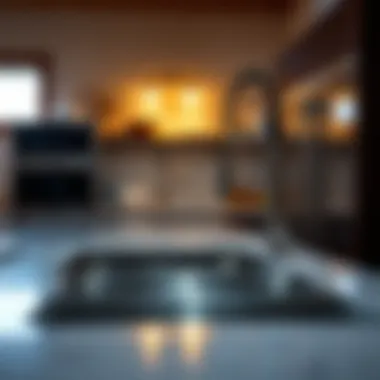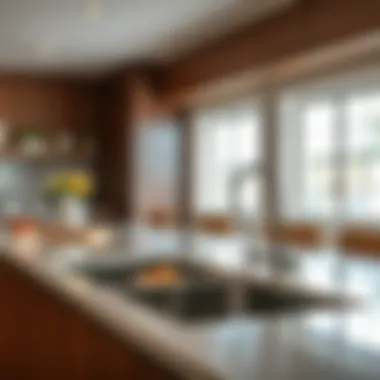In-Depth Look at 28 Inch Stainless Steel Kitchen Sinks


Intro
Selecting the right sink can transform a kitchen from drab to fab. Among the choices, 28 inch stainless steel kitchen sinks stand out. These sinks flex their muscles in both functionality and style. They fit seamlessly into many kitchen layouts, making them timeless picks for homeowners and even professional designers. This guide unravels the intricacies surrounding these sinks, helping you understand the design, durability, and maintenance essentials.
Furniture Styles and Trends
When looking at the kitchen as a whole, understanding the furniture styles that complement your sink choice is essential. The kitchen layout often blends various styles, where your sink plays a pivotal role.
Exploring Popular Furniture Styles
With kitchen aesthetics evolving, the styles people opt for can range from modern minimalist to rustic farmhouse. Here are a few popular styles:
- Modern: Clean lines and sleek finishes. Often paired with stainless steel for a cohesive look.
- Farmhouse: Think wood elements with a country feel. A stainless steel sink can add a refined touch amid this warmth.
- Industrial: Raw materials are key. Stainless steel often becomes a centerpiece in such designs due to its robustness.
Understanding Current Design Trends
Kitchen designs tend to reflect personal taste, but certain trends become almost ubiquitous. For instance, open-concept layouts are still in vogue, bringing ample light and space together. Homeowners also value sustainability, tending towards eco-friendly fixtures which can include water-saving stainless steel sinks. Color trends lean toward neutral tones, where a shiny stainless steel sink can provide a necessary pop of brightness.
Practical Tips for Sink Selection
When it comes time to pick the perfect 28 inch stainless steel kitchen sink, it’s crucial to keep several points in mind to simplify the process.
Factors to Consider When Choosing a Sink
- Material Thickness: A thicker gauge often means more durability and less noise when washing dishes.
- Sink Configuration: Single bowl vs. double bowl – both have their merits. A single bowl is often favored for large pots and pans.
- Finish: Consider brushed versus polished finishes. Brushed may hide scratches better, while polished provides a sleek look.
How to Measure and Optimize Space
When dealing with a standard size like 28 inches, measuring accurately is vital. Be sure to check:
- Cabinet Size: Ensure the sink fits within the existing cabinetry.
- Depth: Deeper sinks can hold more, but they may require modifications in cabinetry.
- Faucet Height: Choose a faucet that gives you enough clearance, especially if you plan on using tall pots.
In the end, the right 28 inch stainless steel kitchen sink can complement both functionality and aesthetic appeal in your kitchen. It’s not just about picking a random sink off the shelf, but about ensuring that it fits perfectly into your living space and meets your lifestyle needs.
"Buying a sink is not just a purchase; it’s an investment in your home’s heart."
Stay tuned, as we delve deeper into installation, maintenance tips, and more about the benefits of choosing stainless steel as your sink material.
Intro to Inch Stainless Steel Kitchen Sinks
In the realm of kitchen design, the sink often becomes the unsung hero, diligently serving its purpose while harmonizing with other decor elements. The 28-inch stainless steel kitchen sink exemplifies this understated but crucial role. Its dimensions are particularly favorable, as they meet the needs of a variety of kitchen sizes.
One key aspect to consider is durability. Stainless steel sinks are famed for their robust nature. They withstand the wear and tear of daily life without losing their charm or functionality. This resilience can be a life-saver, especially in busy households where the kitchen sees a lot of action. Talk about peace of mind!
Beyond toughness, the design flexibility of the 28-inch model is noteworthy. This size is quite versatile, fitting comfortably into compact urban kitchens or larger spaces that require a functional yet beautiful focal point. The style variations, whether farmhouse or undermount, offer opportunities for personal expression while keeping practicality in check.
When it comes to installation readiness, these sinks often shine too. With well-thought-out designs, they can be fitted into most existing countertops with relative ease, minimizing any added stress during home renovations or updates. The intuitive fit allows homeowners to swap out older sinks without going through extensive renovations.
There’s also the appeal of aesthetic integrations. With finishes ranging from polished to brushed, 28-inch stainless steel kitchen sinks can complement many design themes, from modern minimalism to rustic charm. This adaptability adds layers to the potential of any kitchen, enhancing overall ambiance.
"A beautifully installed sink does not just elevate the kitchen design; it can also improve the functionality of the space, making tasks smoother and more enjoyable."
Ultimately, choosing a 28-inch stainless steel kitchen sink is often a strategic decision rooted in a blend of durability, adaptability, and style. It is a smart investment for homeowners looking for functionality while keeping their aesthetic desires in mind. This article will delve deeper into various aspects of these remarkable sinks, ensuring that readers leave with a thorough understanding of their benefits and considerations.
Design Versatility
Design versatility is a cornerstone in the selection of a 28-inch stainless steel kitchen sink. It speaks not only to the aesthetic appeal but also to how seamlessly the sink can fit into various kitchen layouts and styles. The right sink enhances the overall ambiance while meeting functional demands. A versatile design allows homeowners and designers the freedom to choose styles that reflect personal taste and suit practical needs.
Style Variations
Farmhouse
The farmhouse sink stands as a hallmark choice for many traditional and modern kitchens alike. Its deep, front-facing design sets it apart, making it an ideal option for those who want to blend functionality with rustic charm. The prominent feature of a farmhouse sink is its exposed apron, which gives it a striking appearance while making it easier to wash large pots and pans.
Farmhouse sinks are popular due to their size and practicality. They provide ample space for washing and are often designed to be more durable, supporting heavy use without signs of wear. However, they do require specific cabinet modifications, which can add to installation costs.
Undermount
Undermount sinks, on the other hand, are prized for their sleek, clean lines. Installed beneath the countertop, they create a seamless transition between the sink and the counter. This design is particularly beneficial for easy cleaning since there are no rims to collect dirt or debris.
One of the key benefits of an undermount sink is its ability to maximize counter space. Without a lip, you can effortlessly wipe crumbs and spills directly into the sink. While they do require a sturdy countertop and careful installation, the aesthetic payoff is often worth the effort, making them a sought-after choice in contemporary kitchens.
Topmount
Topmount sinks, traditionally known as drop-in sinks, offer a balance of practicality and accessibility. They rest on the countertop, which simplifies installation. One of the standout traits of a topmount sink is its affordability, often making it a favorite for budget-conscious homeowners.
Along with ease of installation, topmount sinks can be replaced with minimal hassle if needed. However, they can present cleaning challenges, as the rim may trap debris. Yet, for many, the trade-off of being simple to install and budget-friendly makes the topmount sink an inviting option.
Color and Finish Options
Brushed Finish
Brushed finish stainless steel sinks provide a subtle texture that can hide fingerprints and water spots, making them a practical option for anyone with a busy kitchen. The specific aspect of a brushed finish is its ability to maintain a clean look with minimal effort. This finish is particularly beneficial for those who wish to reduce maintenance time.
One significant characteristic of brushed stainless steel is its resistance to scratches. Over time, it can add to the sink's charm as tiny scratches become less apparent, enhancing its longevity. While it might not shine like polished finishes, the understated elegance appeals to many modern designs.
Polished Finish
In contrast, polished finish offers a high sheen that can brighten up the kitchen, reflecting light beautifully and giving a sense of spaciousness. This finish is easy to clean and maintain, making it a convenient choice for homeowners who prioritize aesthetics and effortless upkeep.
However, the key drawback is the visibility of fingerprints and water spots, which can necessitate frequent cleaning. Polished finishes tend to require a bit more TLC than their brushed counterparts but their striking appearance often compensates for the effort.
Matte Options
Matte finishes present a more contemporary look, and they have become increasingly popular for those seeking a unique aesthetic. The non-reflective surface of a matte finish can provide a sophisticated touch, especially in minimalistic or modern designs. This finish doesn't show fingerprints as readily, an attractive feature for busy kitchens.
Unique to matte finishes is their ability to absorb light rather than reflecting it. This helps in reducing glare, creating a more subdued ambiance. However, they can be more prone to showing water stains if not cleaned regularly, and some may find scraping from utensils more noticeable. Still, for those striving for a chic appearance, matte finishes deliver both style and ease of use.
Functional Advantages
When it comes to kitchen sinks, functionality often takes precedence over style. This section highlights the functional advantages that 28 inch stainless steel kitchen sinks offer to homeowners and designers alike. Understanding these benefits can help you make informed decisions, ensuring that your kitchen not only looks appealing but also meets your daily demands with ease.
Space Efficiency
Compact Design
The 28 inch stainless steel kitchen sink boasts a compact design that caters perfectly to kitchens with limited space. It doesn’t just fit neatly into tighter spots; it makes the most out of every inch of the countertop. Homeowners find this aspect quite appealing, particularly when they need to balance elegance with functionality. The sink’s streamlined silhouette makes it easy to integrate it into existing decor without crowding the space.


One unique feature of this compact design is its depth. Unlike shallower models, a deeper basin can hold larger pots and pans, allowing for more efficient washing. This is especially beneficial for those who love to cook, as it saves time and effort. However, potential downsides include the need for bending down more to reach the base of the sink, which might not be ideal for everyone.
Maximizing Counter Space
In smaller kitchens, every square foot is precious. The design of a 28 inch sink encourages maximizing counter space. By fitting snugly into your cabinetry, it leaves ample room for meal prep and other kitchen functions. This sink allows for the placement of cutting boards and drying racks right above it or to the side, effectively expanding the usable area.
What sets this feature apart is the opportunity it creates for multi-tasking. Imagine washing vegetables while chopping another ingredient on the adjacent counter. This can significantly enhance cooking efficiency, making meal preparations smoother. Yet, one thing to keep in mind is that not every countertop can easily accommodate additional accessories, which may limit personalization.
Ideal for Smaller Kitchens
The compact nature of a 28 inch stainless steel sink makes it an ideal choice for smaller kitchens or apartments. Space constraints are a common reality in urban settings, and this sink provides a practical solution without sacrificing quality. Its dimensions allow for easy installation in various layouts, fitting into the corner or under cabinets without trouble.
Additionally, this size caters to those who may not prioritize entertaining a large group. The sink is perfect for single-family households or couples who enjoy cooking together. However, it’s essential to consider that larger households may find the sink's capacity limiting, especially during busy cooking sessions.
Practicality in Use
Ease of Cleaning
One major highlight of a stainless steel sink is its ease of cleaning. A simple wipe-down is often sufficient to keep it looking new. Many manufacturers apply a protective coating to the surface, minimizing daily grime build-up. This is music to the ears for those leading busy lives, as less time spent cleaning means more time savoring meals or hosting friends.
What stands out here is the non-porous surface, which resists trapping food particles and bacteria. While this is a huge advantage, using the right cleaning agents is crucial. Household items like vinegar and baking soda are usually sufficient; however, harsh chemicals can damage the sink’s finish over time.
Resistance to Stains
The resistance to stains among stainless steel sinks is another vital functional advantage. When compared to other materials like porcelain, these sinks perform exceptionally well. Food spills, coffee stains, and dark-colored sauces are less likely to mar the surface if cleaned quickly. The key characteristic of stain resistance allows homeowners to maintain a polished appearance with minimal effort.
However, like all materials, stainless steel is not entirely impermeable. Failure to wipe up spills can lead to discoloration, particularly in low-quality sinks. Therefore, being proactive about maintenance is still necessary to uphold the sink’s integrity.
Heat Resistance
Heat resistance is an essential trait for kitchen sinks, especially when dealing with hot pots and pans right after cooking. The stainless steel material can withstand significant temperatures, making it a reliable option for busy kitchens. It’s not rare to place a steaming casserole dish directly into the sink for quick cleaning or drying.
A notable feature here is its ability to retain shape and functionality even under extreme conditions. While some materials may warp, stainless steel maintains its structural integrity, which very much adds to its appeal. On the flip side, if individuals are careless and drop extremely hot items into the sink, minor surface imperfections can occur. It's a reminder that while this material is resilient, a touch of caution goes a long way.
Material Properties
Understanding the material properties of 28-inch stainless steel kitchen sinks is crucial for homeowners seeking both aesthetics and functionality in their kitchen. The composition and durability of these sinks dictate not just their appearance, but how they withstand daily use, ensuring a long-lasting investment in your kitchen upgrade. Let's delve into the specifics.
Stainless Steel Composition
Type of Stainless Steel
The type of stainless steel used in kitchen sinks can determine their quality and performance. Generally, 304-grade stainless steel is preferred due to its high resistance to corrosion and staining. This composition is particularly beneficial for kitchen environments where moisture is a constant factor.
A unique characteristic of 304 stainless steel is its blend of chromium and nickel, which enhances both strength and corrosion resistance. The result is a sink that not only looks sleek but fights wear and tear like a champ.
However, while 304 stainless steel is the best-selling choice, some models may use 430-grade steel, which is less expensive but also less resistant to rust. So, if longevity and durability are on your wish list, opting for 304 stainless steel becomes an obvious choice.
Corrosion Resistance
Corrosion resistance is a significant aspect of selecting a kitchen sink. Stainless steel naturally resists rust and corrosion due to the chromium present in its composition. This renders the sinks particularly suited for use in areas that are frequently in contact with water and food remnants.
One key feature of corrosion resistance is that it maintains the sink's appearance over time, preventing unsightly stains and buildup. Homeowners often see this as a great benefit, as it means lower maintenance efforts and sustained durability. On the downside, it requires proper care to ensure that even small scratches don’t lead to more significant corrosion issues over time.
Nickel vs. Chromium
When discussing nickel vs. chromium, the focus is on the specific enhances each provides to stainless steel sinks. Nickel improves the ability of stainless steel to withstand harsh conditions, while chromium is essential for the formation of a protective layer that stops rust from taking hold.
In the world of kitchen sinks, the blend of these metals produces a robust material that doesn’t easily show signs of staining or dimming. The result is a sink that can survive the rigors of daily kitchen activities. However, it’s vital to balance the cost, as higher nickel content often means higher prices without compromising quality.
Durability and Longevity
Impact Resistance
Impact resistance is another critical feature that determines the overall durability of stainless steel sinks. These sinks can withstand the bumps and bangs of utensils without easily denting or deforming. For families with children or heavy cooking enthusiasts, this characteristic offers a peace of mind.
A well-constructed stainless steel sink generally boasts a high resistance to impact damage, which is crucial for protecting your investment in a busy kitchen. However, keep in mind that while they can take a beating, overly aggressive handling can still lead to signs of wear.
Scratch Resistance
Equally notable is the scratch resistance of stainless steel sinks. While no sink can claim to be entirely scratch-proof, many 28-inch options feature a brushed finish that helps hide light scratches, making them a popular choice for busy kitchens.
This feature is essential for those who want their sink to maintain its aesthetic appeal despite everyday use. On the flip side, harsh cleaners and abrasive scrubbers can strip away this protective finish over time, making gentle care practices essential.
Life Span of Stainless Steel Sinks
The life span of stainless steel sinks is substantial when compared to other materials. With proper care, a high-quality stainless steel sink can last two decades or more. This longevity is a significant advantage for any homeowner looking to invest wisely in their kitchen offerings.
Uniquely, the combination of durability and resistance to various types of damage contributes heavily to this life span. Sinks made from high-grade stainless steel usually enjoy a premium status, leading to less frequent replacements compared to ceramic or plastic alternatives. However, regular maintenance is crucial to achieving this extended life.
"A well-maintained stainless steel sink not only serves well in function but also enhances the overall kitchen aesthetic."
In summary, the material properties of a 28-inch stainless steel kitchen sink are multi-faceted and vital to its performance. With the right composition, resistance to corrosion and damage, and a long life span, these sinks stand out as an excellent choice for modern kitchens.
Installation Considerations
When it comes to 28-inch stainless steel kitchen sinks, installation can make or break the experience of owning one. Not only do installation considerations affect the functional aspects, but they also play a vital role in the overall aesthetic appeal of your kitchen. A well-installed sink enhances usability, ensures proper drainage, and minimizes potential plumbing problems in the long run. Let’s explore the specific elements involved in installation, as well as the benefits and considerations homeowners should keep in mind.
Preparation for Installation
Measuring Counter Space
When measuring counter space for your new sink, accuracy is absolutely key. This process involves determining the dimensions available on your countertop to ensure a snug fit for your sink. A precise measurement not only ensures that the sink will fit but also allows you to plan for any additional fixtures or accessories that might accompany it. One of the key characteristics of measuring counter space is that it helps in avoiding costly errors that could lead to returns or mishaps during installation.
The unique feature here is that using a template provided by the sink manufacturer can assist in visualizing the space required. This process is advantageous as it provides a clear understanding of how the sink will integrate into your kitchen layout. Neglecting this step could lead to a sink that either overwhelms the counter space or feels lost within it, both of which are undesirable outcomes.
Plumbing Adjustments
Proper plumbing adjustments are essential for ensuring that your sink functions flawlessly from day one. It involves modifying existing plumbing to accommodate the size and placement of your new sink. Key characteristics of plumbing adjustments include aligning the sink drain with the house’s existing drainage system and making modifications to water supply lines.
This is a beneficial choice for your kitchen sink installation because improper plumbing can lead to water leaks and drainage issues down the line, creating headaches you wouldn’t wish on your worst enemy. The unique aspect of plumbing adjustments is their tailored approach, ensuring that every homeowner’s needs are met without a one-size-fits-all approach. However, incorrect plumbing modifications can lead to substantial costs and damage, making this a crucial step that should not be overlooked.
Choosing the Right Hardware
Selecting the right hardware for your sink installation is also crucial, as it directly affects functionality and aesthetics. The right mounting brackets, faucet attachments, and drain fittings ensure that everything is fitted securely and works as intended. This hardware selection is a popular choice among homeowners because using high-quality materials can greatly enhance the life expectancy of your installation.
One unique feature of choosing the right hardware is that it can sometimes elevate the overall design of your kitchen. Opting for stylish faucet designs or robust mounting systems can not only improve functionality but also add a touch of elegance to your kitchen environment. While the wrong hardware can lead to instability or leakage, skimping on this factor is rarely worth the risks.
Professional vs. DIY Installation


Advantages of Professional Help
Hiring a professional for installation offers a suite of benefits that many homeowners may overlook. Experience matters, particularly when it comes to something as critical as plumbing and sink installation. A professional installer understands the finer points of fitting, plumbing adjustments, and making sure everything complies with local codes. This reduces the chances of future repairs, making it a worthwhile investment for homeowners.
The key characteristic here is that professionals typically carry warranties for their labor. This provides an extra layer of security for homeowners, knowing that if something goes wrong, there’s someone to call. However, engaging a professional can come at a higher cost compared to DIY efforts, which some may consider a disadvantage.
DIY Tips for Installation
For those feeling handy, DIY installation can be a fulfilling endeavor. One of the main advantages is the potential for significant cost savings. With the right tools and a little research, the process can be straightforward. Key characteristics of DIY installation include hands-on experience, which can enhance your skill set for future projects. There’s something satisfying about completing such a task with your own two hands.
However, one should take a measured approach to this option. If you lack plumbing knowledge or aren’t confident with tools, seeking guidance or even hiring a professional for tricky parts of the installation can save you time and prevent errors. Utilizing online resources or instructional videos can guide you step-by-step, but the risks of improper installation are always present.
Common Mistakes to Avoid
It’s all too easy for first-time installers to overlook key elements during the installation of a kitchen sink. A common mistake is failing to double-check measurements, which can lead to a lot of unnecessary frustration. Additionally, not securing plumbing fixtures tightly enough can lead to leaks, which are the bane of any homeowner’s existence. The key characteristic about common mistakes is that most of them can often be easily avoided with careful planning and attention to detail.
The unique benefit of understanding and acknowledging these common pitfalls lies in the peace of mind it provides. When you proactively learn about what errors to avoid, you empower yourself to make more informed decisions during the installation process. Missed steps or inaccuracies may culminate in costly fix-ups later, a headache best avoided.
Maintenance and Care
Proper maintenance and care of your 28-inch stainless steel kitchen sink is crucial. Not only does it enhance the sink's aesthetic appeal, but it also prolongs its lifespan. A well-maintained sink can resist scratches, stains, and rust, ensuring it remains a focal point of your kitchen. This section discusses pragmatic cleaning regimens and preventative measures to keep your sink in top shape.
Cleaning Regimens
Daily Cleaning
Daily cleaning is simple but essential in retaining the luster of your sink. This task, often overlooked, contributes significantly to a sink's cleanliness. A quick wipe down with mild soap and warm water can remove food particles and prevent filth buildup.
One standout characteristic of daily cleaning is its consistency. Doing it regularly stops grime before it takes hold, making deep cleaning less daunting. You wouldn't let dust pile up on your cherished bookshelf, right? Likewise, keeping your sink clean breathes life into the kitchen. A unique feature of this method is how it encourages a mindful routine in the kitchen. Plus, it’s easy on your schedule—just a few minutes after meal prep.
Deep Cleaning Techniques
While daily cleaning keeps mess at bay, deep cleaning techniques are vital for maintaining your sink's integrity. This involves more thorough scrubbing and, perhaps, using baking soda or vinegar to tackle lingering stains. Deep cleaning works wonders on both aesthetic and functional levels, helping to clear blockages in drains and ensuring that your kitchen stays hygienic.
The primary characteristic of deep cleaning techniques is their intensity. They require more time and effort than your everyday wash but yield significant results. A unique advantage of this method is its transformative power; it can bring back a sink's shine that may have faded over time. However, remember that frequent deep cleaning can wear down the surface if done too often.
Avoiding Harsh Chemicals
Avoiding harsh chemicals is another crucial aspect of sink care. Using natural cleaners, or those specifically designed for stainless steel, preserves the finish while ensuring you are not introducing harmful substances into your home environment. This choice leans heavily on the notion of sustainability, allowing you to clean responsibly.
The significant characteristic of avoidance here is its positive impact on both health and the environment. By opting for non-toxic products, not only do you safeguard your household but also reduce your ecological footprint. A downside is that, occasionally, these products may require a bit more elbow grease to achieve the same level of cleanliness as stronger chemical alternatives.
Preventing Damage
Taking steps to prevent damage is integral to maintaining your kitchen sink. By focusing on a few key areas, you can keep your sink from deterioration and maintain its function.
Avoiding Scratches
Avoiding scratches is critical as a pristine surface preserves the overall look of the sink. Consider how easily a fine scratch can turn into a wider blemish. Being mindful of dishes and utensils can significantly minimize risks; using mats or pads during dishwashing can also help.
The defining feature of this preventative measure is the awareness it cultivates. Knowing how simple choices impact the finish of your sink helps in its upkeep. However, avoiding scratches entirely can be challenging when juggling dishes and cleaning.
Dealing with Rust
Dealing with rust is particularly significant when it comes to stainless steel. Though stainless steel is resistant to rust, it isn’t impervious. Any water left standing for prolonged periods can cause rust spots to rear their ugly heads. The best strategy here is to dry the sink thoroughly after use.
Rust prevention hinges on vigilance. A key characteristic is ensuring every bit of water is wiped off, drastically reducing the chance of rust formation. An advantage is that this habit fosters a clean environment and instills a sense of pride in your kitchen chores. On the flip side, if you're not diligent, rust might sneak in before you’ve even noticed it.
Proper Drainage Maintenance
Finally, maintaining proper drainage is vital to the long-term functionality of your sink. Blockages can lead to water pooling and undesirable odors. Regularly check and clean the drain to ensure it’s free-flowing, which is essential for both cleanliness and operational efficiency.
The major characteristic of proper drainage maintenance is its proactive approach. Instead of waiting for a problem to arise, taking initiatives early can save you time and costs down the road. One unique aspect of this maintenance is how it requires very little time but yields extensive benefits. However, neglecting this aspect can mean facing frustrating plumbing issues later.
Good maintenance practices today protect your investment tomorrow.
Adopting these strategies not only keeps your stainless steel sink looking sharp but also extends its lifespan. In a space like the kitchen, where cleanliness is paramount, these habits will serve you well.
Comparative Analysis with Other Sink Materials
When considering the best options for your kitchen, it’s crucial to analyze how stainless steel sinks stack up against alternatives like ceramic and composite sinks. This comparative lens offers insights into usability, aesthetic appeal, and how well these sinks integrate into various kitchen designs. Understanding the pros and cons of each type can empower homeowners, designers, and renovators to make informed decisions that elevate their culinary spaces.
Ceramic Sinks
Pros and Cons
Ceramic sinks present a beautiful contrast to stainless steel, often praised for their smooth finish and color options. One major plus is their easy-to-clean surface, which can enhance the visual appeal of your kitchen. However, they do have downsides. Ceramics are prone to chipping, and cracks can mar their beauty, making them less practical in households with active cooking routines. Their weight also necessitates robust cabinetry for support, complicating installation. In terms of longevity, while they can last quite a while if maintained properly, they won’t handle heavy impact like stainless steel.
Durability Comparison
In the realm of durability, ceramic sinks lag behind their metal counterparts. While they resist scratching better than stainless steel, they are more susceptible to physical damage from dropped pots or pans. Unlike stainless steel's flexible durability that bends under pressure, ceramic can shatter. Hence, if you prioritize a sink that lasts through bustling kitchen activity, ceramic may not be your first choice despite its attractive facade.
Aesthetic Considerations
Ceramic sinks excel in aesthetic appeal. They can incorporate various styles, from quaint farmhouse to sleek modern. The glaze finish can come in multiple colors, thus easily matching or contrasting with kitchen decor. However, potential buyers must consider how well they harmonize with other materials in their kitchen. If you foresee a culinary environment demanding high durability and resistance to wear and tear, the beauty of ceramic might fade compared to its practical functionalities.
Composite Sinks
Strengths of Composite
Composite sinks, made from a resin and stone mixture, combine some best features from various materials. The strength factor is a significant draw, as these sinks resist scratches, dents, and are even less affected by temperature changes. They might not be as popular as stainless steel, yet their versatility in design options makes them quite appealing for unique kitchen designs. An attention-grabbing feature is their compatibility with kitchen colors, often available in multiple finishes, incorporating shades unlucky with stainless methods.
Design Flexibility
Design flexibility is where composite sinks see their brightest day. They can be molded into various shapes and sizes, adding to their trendiness in contemporary kitchens. Unlike stainless steel, which can sometimes appear industrial, composites allow for a more homey or nuanced look, suitable for diverse aesthetics. This flexibility can truly cater to custom kitchen designs, making composite sinks a smart choice for those looking to stand out.
Maintenance Differences
When it comes to maintenance, composite offers a substantial ease factor; they tend to require more straightforward care. Unlike stainless steel, you often won't need to polish away water spots or scrub intensely to avoid scratches due to their engineered surfaces. Nevertheless, it’s important to note that heat resistance isn’t as robust compared to stainless. Using hot pots directly on composite surfaces can lead to damage, raising awareness about ideal usage.
"When looking for a sink, knowing the differences in material can drastically improve your kitchen's efficiency and aesthetic".
From practical aspects to aesthetic value, weighing the differences between stainless steel, ceramic, and composite sinks helps in selecting the appropriate kitchen fixture. Each comes with its own strengths and weaknesses, underscoring the importance of aligning sink selection with your kitchen’s functionality and style. This analysis encourages informed choices, ultimately elevating the user experience in the heart of the home.
Eco-Friendly Considerations
As we dive into the world of kitchen sinks, the topic of eco-friendliness becomes increasingly pertinent. Homeowners today not only seek functionality and style in their kitchen fixtures but also prioritize sustainability. This section hones in on eco-friendly practices that can transform the 28-inch stainless steel kitchen sink into an environmentally responsible choice. From recyclability to water-saving features, understanding these considerations can make a significant impact on kitchen design while minimizing environmental footprint.


Sustainability of Stainless Steel
Recyclability
Recyclability stands as a hallmark of stainless steel. Unlike many materials that end up in landfills, stainless steel is almost fully recyclable. When it's time to replace or upgrade a sink, the old one can be melted down and transformed into new products. This cycle not only conserves resources but also significantly reduces waste. Given concerns about the increasing volume of waste generated each year, choosing a material that can be reused is a beneficial aspect of sustainability practices in any household.
Moreover, the steel recycling process requires less energy compared to producing new steel, further enhancing its profile as a responsible option. It means that by selecting a stainless steel sink, you are contributing to a larger effort to promote a circular economy—where materials are continually cycled through reuse rather than discarded.
Energy Efficiency in Production
Another critical feature about stainless steel is its energy efficiency during production. The process to manufacture stainless steel sinks consumes less power compared to the fabrication of ceramic or plastic sinks. This efficiency plays a crucial role in reducing the overall carbon footprint of the product.
By using advanced technologies to streamline production, manufacturers are able to reduce waste and energy consumption. Opting for stainless steel allows consumers to support these energy-efficient practices without compromising on quality or durability. This feature makes it an ideal choice for those who want to blend style with sustainability in their kitchens.
Choosing Eco-Friendly Products
Water-Saving Features
In today’s hasty world, where water conservation is of utmost importance, having water-saving features in kitchen sinks is a huge advantage. Many modern 28-inch stainless steel sinks come equipped with innovative designs that limit water flow without compromising performance. These sinks can provide high water pressure while using less water, reducing overall consumption considerably.
This feature not only contributes to lesser utility bills but also aids in conserving a precious resource. In regions where water scarcity is a pressing issue, these water-saving characteristics can make a tangible difference, ensuring that households play their part in sustainable living.
Non-toxic Finishes
Another consideration revolves around non-toxic finishes on sinks. Some manufacturers offer eco-friendly finishes that are free from harmful chemicals often found in traditional coatings. This is especially relevant for kitchens where food is prepared. Non-toxic finishes ensure that no harmful substances leach into food or water, thus promoting health safety within the home.
By opting for sinks with these types of finishes, homeowners can make conscious choices that protect not just their families, but also the environment. Implementing these eco-friendly products can bolster a commitment to greener living while enhancing the overall aesthetics of the kitchen space.
Popular Brands and Models
When selecting a kitchen sink, particularly a 28-inch stainless steel model, the choice of brand is often as critical as the material itself. Renowned brands bring with them established reputations, consistent quality, and a wide range of options that cater to various aesthetic and functional needs. This section delves into the significance of knowing popular brands and models that dominate the market, allowing homeowners and designers to make informed choices that align with their preferences and maintenance expectations.
Top Manufacturers
Brand Reputation
The brand reputation of manufacturers significantly shapes a buyer's confidence in their product. A company known for delivering high-quality stainless steel sinks often uses robust materials and innovative design techniques, which can lead to longer-lasting products. For instance, brands like Kohler and Moen have established themselves as reliable names in the industry due to their commitment to quality and customer satisfaction. Choosing a brand with a strong reputation ensures that you’re not just buying a sink, but investing in a product that will withstand the rigors of daily use without developing scratches or stains easily. However, it's crucial to balance reputation with specific user needs, as some lesser-known brands can also surprise with quality offerings.
Customer Reviews
Customer reviews play a pivotal role in understanding how a sink performs in real-world situations. A sink that looks fantastic in advertisements may not necessarily fulfill user expectations when it comes to durability and ease of cleaning. Reading through reviews allows potential buyers to gauge the experiences of others regarding installation processes, day-to-day functionality, and even post-purchase customer service. For instance, many users appreciate the feedback regarding noise levels—since some sinks are quieter than others, this can be a game-changer for those in open-plan designs. However, take those reviews with a grain of salt as every user's experience can be quite subjective.
Warranty Considerations
Warranty considerations are a vital aspect when selecting a kitchen sink. A generous warranty reflects a manufacturer's confidence in its product's longevity. Brands like Franke often offer extensive warranties, which can provide peace of mind for buyers. A good warranty not only covers structural defects but may also include issues related to scratches or discoloration.
While a lengthy warranty can be a positive indicator of quality, it’s also essential to read the fine print. Some warranties may have stipulations or limitations that could leave you disappointed if not thoroughly understood. Knowing the warranty terms before purchase is crucial; it can mean the difference between a wise investment and a potential headache down the line.
Model Comparisons
Feature Analysis
When it comes to feature analysis, different models may come with specific attributes catering to unique user needs. Some sinks may include additional soundproofing features—like foam padding on the underside to minimize noise when washing dishes. Others may boast deeper basins that can handle large pots and pans—a significant plus for avid cooks.
Understanding which features are essential to you can streamline the selection process. Not all models may offer the same level of practicality, and knowing what you require also helps in narrowing down your options effectively.
Price Range Overview
The price range overview for 28-inch stainless steel kitchen sinks varies significantly based on brand, model, and features. While some may find themselves drawn to premium options that guarantee certain aesthetics or functionalities, it’s important to remember that more expensive does not always mean better. Budget-conscious shoppers need to consider durable options without overextending their finances.
It’s wise to compare prices and functionalities across various models—sometimes, mid-range choices from reputed brands might offer everything you need without breaking the bank. Exploring different retailers and platforms can also unveil promotional opportunities that can impact your final purchase decision.
Best Selling Models
Focusing on best selling models provides insights into what many consumers deem favorable. Models like Elkay’s Gourmet series have gained traction due to their versatile designs and practical features. Examining what makes these models popular, whether through stylish designs or reinforced durability, can guide buyers in their choices. By prioritizing proven best-sellers, homeowners may feel more assured that their choice has been validated by the experiences of other buyers. However, also consider that what works for the masses may not necessarily work for your unique kitchen needs.
Ultimately, delving into the landscape of popular brands and models helps transform the daunting task of choosing the right kitchen sink into a more informed process filled with clarity about features, pricing, and trusted manufacturers.
Trends in Kitchen Design
Understanding the trends in kitchen design is crucial for anyone looking to invest in a 28-inch stainless steel kitchen sink. Homeowners and designers alike want to ensure that their choices reflect current styles while also maximizing functionality. Trends not only shape the aesthetic appeal of the kitchen but also influence how the space is used, and the materials selected. With the kitchen being a central hub in any home, incorporating current trends can enhance both usability and value.
Contemporary Aesthetic
Minimalist Trends
Minimalism has carved a prominent niche in the kitchen design arena. This trend emphasizes simplicity, clean lines, and functional beauty, making it a fitting choice for those remodeling their spaces. A key characteristic of minimalist trends is the less is more approach, focusing on essential elements without unnecessary clutter. The beauty of a stainless steel sink lies in its sleekness; it complements the minimalist ethos beautifully.
A unique feature of minimalist trends is the open-concept layout. This allows the kitchen to blend seamlessly with the living or dining area, creating a sense of spaciousness. In such designs, a 28-inch sink serves a dual purpose. It remains functional while also contributing to an uncluttered visual that is pleasing to the eye. The practicality of stainless steel sinks—resistant to stains and easy to clean—makes them especially suitable for minimalist spaces, as they align with the desire for efficiency and straightforward upkeep. However, there can be a downside; minimalist spaces may lack warmth or personalization without careful decor choices.
Incorporating Technology
The incorporation of technology into kitchen design is another emerging trend. Smart sinks and faucets equipped with touchless controls or voice activation signify a shift towards a more modern, tech-savvy kitchen experience. This transformation offers convenience, allowing busy homeowners to multitask efficiently while cooking or cleaning.
A distinctive aspect of incorporating technology is connectivity. Smart appliances offer energy-saving features and improved functionalities that simplify daily tasks. For example, a smart sink can adjust water temperature, volume, or even notify users about maintenance needs, such as leaks or blockages. This adds value, making stainless steel sinks not just a practical choice but also a smart investment. Nevertheless, it's necessary to weigh the potential disadvantages, such as the higher cost of smart models and the necessity of having stable internet connectivity.
Classic Styles
Timeless Designs
Timeless designs have a charm that never seems to wane. This particular style often features traditional shapes and elegant detailing, appealing to those who appreciate the old-world aesthetics. Key characteristics include intricate patterns, raised edges, and decorative elements that can elevate the kitchen's overall look.
The uniqueness of timeless designs is their ability to blend seamlessly with various home styles—from classic to contemporary. A 28-inch stainless steel sink can fit well into these designs without overpowering the space. Its durability and neutral appearance allow it to withstand changing trends, providing a long-lasting solution that remains relevant over time. However, homeowners must be mindful that such designs can sometimes require more intricate maintenance compared to modern counterparts.
Color Schemes for Vintage Looks
Color schemes geared toward vintage aesthetics can significantly impact the ambiance of a kitchen. The hues popular in vintage styles often include muted pastels or earthy tones that provide warmth and authenticity. Complementing a 28-inch stainless steel sink, these colors can create a pleasing contrast, making the sink an eye-catching feature.
A standout aspect of vintage-inspired color schemes is the ability to create a storytelling element in design. Incorporating warm, inviting colors invokes nostalgia, turning the kitchen into a cozy gathering space. For example, pairing a creamy white or soft sage cabinetry with a modern sink creates a balance between old and new—a harmonious feel. The challenge with these palettes, though, is ensuring they don't clash with the sink’s metallic finish, which may lead homeowners to rethink their color selections or use accents to bridge the gap.
Closure
The conclusion hammers home the pivotal role that 28 inch stainless steel kitchen sinks play in modern homes. Not merely a functional element, these sinks emerge as a cornerstone of kitchen design and practicality. Their significance can be distilled into a few fundamental themes: durability, design versatility, and ease of maintenance.
Durability stands out as the key advantage. Homeowners often seek fixtures that can withstand the test of time, and stainless steel sinks excel in this regard. With their resistance to rust, stains, and even dents—albeit with care—they offer a long-lasting solution for busy kitchens, where cooking and cleaning are daily rituals.
Design versatility is another essential facet. The ability to fit seamlessly into various kitchen styles—from sleek, contemporary designs to more rustic, farmhouse aesthetics—makes these sinks adaptable to changing trends and personal preferences. Homeowners can choose from a variety of finishes, styles, and mounting options, ensuring that their sink not only functions effectively but also complements the overall kitchen decor.
Ease of maintenance is a significant consideration for those who lead busy lives. Regular cleaning doesn't need to feel like a chore, as stainless steel sinks are relatively easy to maintain. Using simple cleaning agents and practices can keep the sink looking new, avoiding the more intensive care that some materials require.
In summary, opting for a 28 inch stainless steel kitchen sink is a decision that resonates with long-term value. Whether tackling routine dishes or prepping for a dinner party, these sinks embody practicality and style. As homeowners plan their kitchens, it is vital to recognize the added benefits offered by these sinks, which enrich spaces not just functionally, but also aesthetically.
"Choosing the right sink can transform not only your kitchen's functionality but also its elegance."
Looking ahead, investing time and resources into selecting the right sink will ultimately pay off in enhanced kitchen efficiency and look. Educated choices—backed by understanding the nuances discussed in this guide—will empower homeowners and designers alike, keeping kitchens both practical and chic for years to come.















